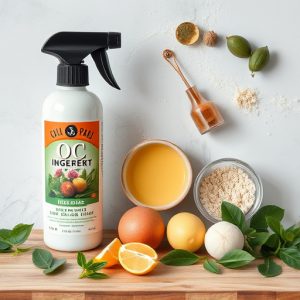OC Spray: Composition, Effectiveness, and Legal Use Guidelines
OC (Oleoresin Capsicum) spray is a non-lethal self-defense tool that temporarily incapacitates attac…….
OC (Oleoresin Capsicum) spray is a non-lethal self-defense tool that temporarily incapacitates attackers by causing intense irritation to the eyes, skin, and respiratory system with its active ingredient, capsaicinoid, derived from chili peppers. The effectiveness of OC spray depends on understanding both its potent ingredients and the environmental conditions under which it is used, as these factors can significantly impact its performance. Legal authorization, proper use, and safety considerations are paramount; users must be aware of local regulations regarding OC spray and ensure they are trained to use it effectively without causing harm to themselves or others. Environmental assessment, particularly concerning wind direction, is crucial to avoid accidental exposure. It's important to remember that OC spray should only be used as a last resort after attempting de-escalation to prevent the unnecessary escalation of conflicts. Always adhere to legal guidelines and use OC spray responsibly.
less lethal defense systems have gained prominence as a non-fatal alternative in personal protection and law enforcement. This article delves into the intricacies of one such system: OC Spray, also known as pepper spray. We explore its key ingredients, the science behind its impact, and its efficacy against diverse threats. A critical examination of legal frameworks will guide users on appropriate use, ensuring safety and compliance. Finally, we provide best practices for employing OC Spray effectively in self-defense scenarios. Join us as we dissect the world of OC Spray ingredients and their role in personal protection.
Understanding OC Spray: Composition and Mechanisms
OC spray, commonly known as pepper spray, is a non-lethal self-defense tool that temporarily incapacitates an assailant by causing intense irritation to their eyes and respiratory system. The acronym ‘OC’ stands for oleoresin capsicum, which is derived from natural sources including various chili peppers. The primary ingredients in OC spray, such as capsaicin and related capsaicinoids, are what deliver the intense heat and irritation. When deployed, the active compounds penetrate the eyes, mucous membranes, and respiratory tract of an attacker, triggering a strong reflex to close the eyes and lungs, which effectively hinders their vision and ability to breathe, thus rendering them defenseless for a few minutes. The effects are reversible upon washing the affected areas with water or drenching the person with a harmless fluid that neutralizes the spray’s agents. Understanding the ingredients and mechanisms of OC spray is crucial for users to employ it effectively and safely in self-defense situations, ensuring both their own and bystanders’ safety. It’s also important for users to be aware of environmental factors and wind conditions that might influence the spray’s effectiveness when used outdoors.
The Role of Capsaicin in OC Spray Ingredients
OC sprays, commonly known as pepper sprays, are a non-lethal means of self-defense that rely on the active ingredient capsaicin derived from chili peppers. Capsaicin is the compound responsible for the intense heat and irritation characteristic of chili peppers, and it serves as an effective agent in deterring attackers by causing a profound discomfort and temporary loss of vision and respiratory function. The formulation of OC spray ingredients must be precise to ensure that capsaicin is delivered efficiently under various conditions. Typically, the concentration of capsaicin ranges from 10 to 50 million Scoville Heat Units (SHU), which is potent enough to incapacitate an assailant without causing long-term harm. The other ingredients in OC spray are designed to work synergistically with capsaicin, enhancing its delivery and stability, while also ensuring that the spray’s effectiveness remains consistent across different environmental factors such as wind, temperature variations, and potential contamination with substances intended to neutralize its effects. Understanding the role of capsaicin in OC spray ingredients is crucial for optimizing the product’s defensive capabilities and user safety. Properly formulated, OC sprays provide a reliable layer of protection, deterring aggressors by inducing rapid onset of pain and mucous membrane irritation without the lethal consequences associated with other self-defense tools.
Evaluating the Effectiveness of OC Spray Against Various Threats
OC spray, commonly known as pepper spray, is a less lethal defense mechanism that has gained widespread use among law enforcement and civilians alike for its rapid incapacitating effect. The effectiveness of OC spray hinges on its active ingredients, which are capsaicinoids derived from natural chili peppers. These compounds irritate the eyes, skin, and respiratory tract of an assailant upon contact or inhalation. When evaluating its efficacy against various threats, it’s crucial to consider the ingredients’ concentration, as this dictates the intensity of the irritation caused. For instance, a higher concentration can be more effective in deterring and subduing aggressive behavior from individuals under the influence of drugs or alcohol, where pain perception might be altered. Additionally, the spray’s delivery system plays a significant role in its performance; factors such as range, wind conditions, and the target area’s accessibility are critical in determining its success against different types of threats, including uncooperative suspects during law enforcement operations or personal self-defense scenarios. Understanding the ingredients’ potency and the environmental variables involved ensures that OC spray remains a reliable and effective less lethal option for various defense situations.
Legal Considerations and Regulations Governing OC Spray Use
OC spray, commonly known as pepper spray, is a less lethal defense mechanism that serves as an effective deterrent in various self-defense scenarios. The legal landscape governing the use of OC spray is multifaceted, with regulations varying by jurisdiction. In the United States, for instance, the legality of OC spray is determined at both the federal and state levels. Federal law allows the use of OC spray under certain conditions, particularly for self-defense, law enforcement, and crowd control. However, specific regulations regarding the purchase, possession, and use of OC spray are dictated by individual states, with some states imposing restrictions on who can carry it and in what strength.
The ingredients in OC spray are crucial to its effectiveness and its legal status. The primary active ingredient in OC sprays is oleoresin capsicum (OCN), which is derived from natural sources such as cayenne peppers. Other related capsaicinoids may also be present. It’s important for consumers to understand that the formulation and concentration of these ingredients can influence the effectiveness of the spray and compliance with local regulations. Manufacturers are required to adhere to strict standards set forth by the American Society for Testing and Materials (ASTM) to ensure the safety and consistency of OC spray products. Users must be aware of their jurisdiction’s specific laws, as some locations may regulate or even ban certain ingredients found in OC sprays. Understanding these legal considerations is essential for responsible use and ownership of OC spray as a less lethal defense option.
Practical Application: Best Practices for Using OC Spray Safely and Effectively
When deploying OC (Oleoresin Capsicum) spray as a less lethal defense mechanism, adherence to best practices is paramount for both personal safety and legal compliance. OC sprays are formulated with active ingredients derived from chili peppers, specifically capsaicinoid, which causes intense irritation upon contact with the eyes, skin, or respiratory system of an assailant. To use this tool effectively, it’s crucial to familiarize oneself with its limitations and proper application techniques. A critical best practice is to ensure that you are legally authorized to use OC spray in your jurisdiction and understand the legal implications should it be used in self-defense. Training with the spray can enhance accuracy and effectiveness; regular practice sessions should be incorporated into your routine to maintain proficiency.
Safety is a primary concern when handling OC spray. It’s essential to know the ingredients and potential effects, not only for the intended target but also for yourself and bystanders. Wind conditions can carry the spray back towards you or innocent parties, so it’s important to consider the environment before deploying the spray. Additionally, always keep the spray aimed away from your face and eyes, as accidental contact can lead to severe pain and temporary blindness. It’s also advisable to use OC spray only after less forceful options have been attempted or deemed ineffective, thus avoiding unnecessary escalation of a confrontation. Understanding the potential effects of the spray’s ingredients on individuals with certain medical conditions is equally important, as some may react differently than others. Always follow local laws and regulations regarding the use of OC spray and prioritize de-escalation tactics whenever possible.


